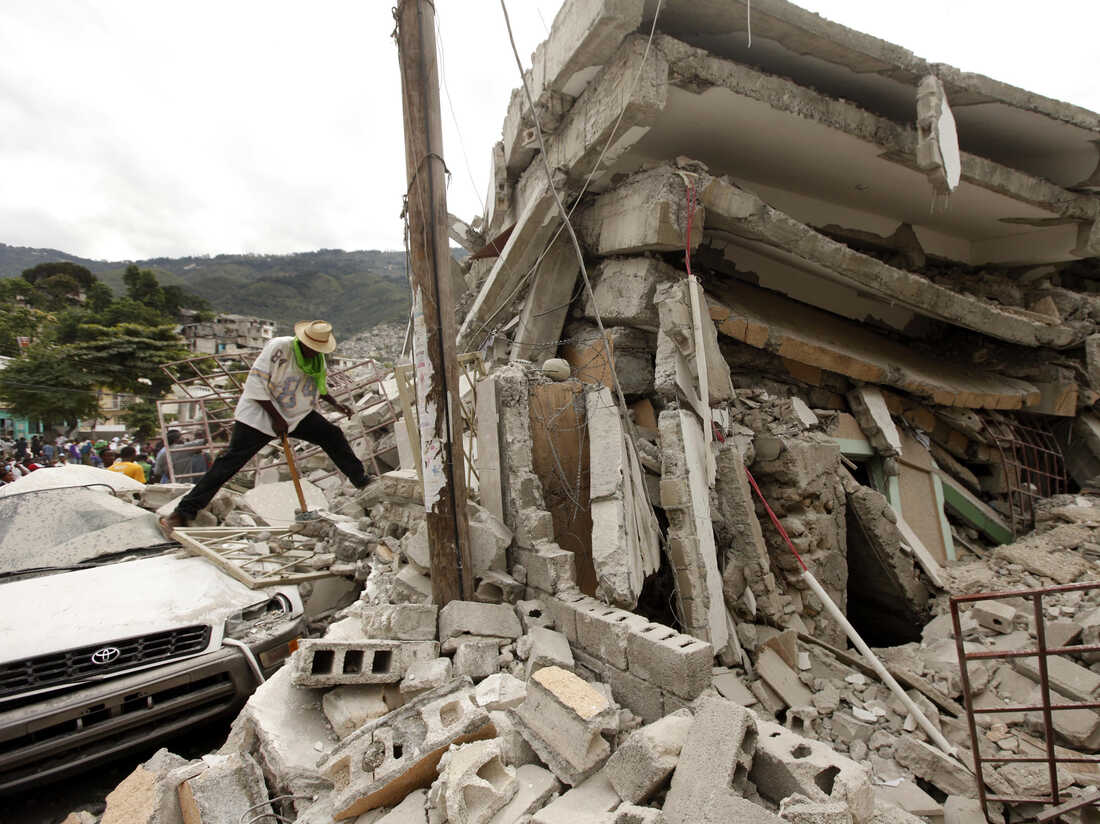BY BEN FINLEY ASSOCIATED PRESS
AUGUST 16, 2021

Earthquakes have been wreaking havoc in Haiti since at least the 18th century, when the city of Port-au-Prince was destroyed twice in 19 years. Saturday’s powerful quake killed hundreds and injured thousands more. Eleven years earlier a temblor killed tens of thousands of people, if not hundreds of thousands.
Haiti sits near the intersection of two tectonic plates that make up the Earth’s crust. Earthquakes can occur when those plates move against each other and create friction. Haiti is also densely populated. Plus, many of its buildings are designed to withstand hurricanes — not earthquakes. Those buildings can survive strong winds but are vulnerable to collapse when the ground shakes.
___
WHAT MAKES HAITI PRONE TO EARTHQUAKES?
The Earth’s crust is made up of tectonic plates that move. And Haiti sits near the intersection of two of them — the North American plate and the Caribbean plate.
Multiple fault lines between those plates cut through or near the island of Hispaniola, which Haiti shares with the Dominican Republic. What's worse, not all of those fault lines behave the same way.
“Hispaniola sits in a place where plates transition from smashing together to sliding past one another,” said Rich Briggs, a research geologist at the U.S. Geological Survey’s Geologic Hazards Science Center.
“It's like a rock stuck in the track of a sliding glass door," he said. "It just does not want to move smoothly because it’s got so many different forces on it.”
___
WHAT CAUSED THE MOST RECENT QUAKE?
Brewery Blocks
Downtown development has been slow to fill during pandemic
Saturday's magnitude 7.2 earthquake likely occurred along the Enriquillo-Plantain Garden fault zone, which cuts across Haiti's southwestern Tiburon Peninsula, according to the USGS.
It's the same fault zone along which the devastating 2010 earthquake occurred. And it's likely the source of three other big earthquakes in Haiti between 1751 and 1860, two of which destroyed Port-au-Prince.
Earthquakes are the result of the tectonic plates slowly moving against each other and creating friction over time, said Gavin Hayes, senior science adviser for earthquake and geologic hazards at USGS.
“That friction builds up and builds up and eventually the strain that’s stored there overcomes the friction,” Hayes said. “And that’s when the fault moves suddenly. That’s what an earthquake is.”
___

WHY CAN EARTHQUAKES IN HAITI BE SO DEVASTATING?
It's a combination of factors that include a seismically active area, a high population density of 11 million people and buildings that are often designed to withstand hurricanes — not earthquakes.
Typical concrete and cinder block buildings can survive strong winds but are vulnerable to damage or collapse when the ground shakes. Poor building practices can also play a role.
The 2010 quake hit closer to densely populated Port-au-Prince and caused widespread destruction. Haiti’s government put the death toll at more than 300,000, while a report commissioned by the U.S. government placed it between 46,000 and 85,000.
“I think it’s important to recognize that there’s no such thing as a natural disaster,” said Wendy Bohon, a geologist with Incorporated Research Institutions for Seismology. “What you have is a natural hazard that overlaps with a vulnerable system.”

___
WHAT DOES THE FUTURE HOLD?
Geologists say they cannot predict the next earthquake.
“But we do know that earthquakes like this can cause similar-sized earthquakes on the next portion of the fault,” said Hayes of USGS. “And it’s quite a significant hazard in places that don’t have the construction practices to withstand the shaking.”
Construction of more earthquake-resistant buildings remains a challenge in Haiti, which is the poorest nation in the Western Hemisphere.
Before Saturday's quake, Haiti was still recovering from the 2010 earthquake as well as Hurricane Matthew in 2016. Its president was assassinated last month, sending the country into political chaos.
And while there have been some success stories of Haitians building more earthquake-resistant structures, the country has lacked a centralized effort to do so, said Mark Schuller, a professor of anthropology and nonprofit and NGO studies at Northern Illinois University.
Haiti's government has become increasingly weak, while non-governmental organizations focus on their own compartmentalized projects.
“There is technical knowledge in Haiti. There are trained architects. There are city planners. That’s not the problem,” Schuller said. “The problem is a lack of funding for coordination, and lack of political will from donors (to organizations providing aid).”

August 16, 2021
JACLYN DIAZ

Locals recover their belongings Sunday from their homes destroyed in the earthquake in Camp-Perrin in Les Cayes, Haiti.Joseph Odelyn/AP
It happened again.
Over the weekend, Haiti was hit by a magnitude 7.2 earthquake that crumbled homes and buildings and killed more than 1,200 people.
Rescuers are still working to find survivors amid the rubble. The death count is expected to rise.
More than a decade ago, a similar quake left an estimated 220,000 dead, more than 1 million people displaced and roughly 300,000 injured.
These two events are part of Haiti's history of major destructive earthquakes, records of which go back centuries.
Researchers say the country's unique geology make it seismically active — and prone to devastating earthquakes. A combination of factors, however, leaves the country especially susceptible to damage from these events.
Why is Haiti so susceptible to earthquakes?
Haiti sits on a fault line between huge tectonic plates, big pieces of the Earth's crust that slide past each other over time. These two plates are the North American plate and the Caribbean plate.
There are two major faults along Hispaniola, the island shared by Haiti and the Dominican Republic.

A map of the 2010 earthquake in Haiti shows dotted orange lines indicating fault lines. The nation sits on a fault line between huge tectonic plates of the Earth's crust — the North American plate and the Caribbean plate.Alyson Hurt/NPR
The southern one is known as the Enriquillo-Plantain Garden fault system.
Article continues after sponsor message
It's this fault that the U.S. Geological Survey says caused Saturday's quake and the same one that caused the January 2010 earthquake.
The USGS believes the Enriquillo-Plantain Garden fault zone can be blamed on other major earthquakes from 1751 to 1860. The agency said none of these quakes has been officially confirmed in the field as associated with this fault, however.
A history of catastrophic earthquakes in Haiti
One of the earliest major recorded earthquakes in Haiti occurred in the 1700s, according to the USGS. Others followed, with researchers cataloging events that left hundreds dead and destroyed homes and businesses.
Nov. 21, 1751: A major earthquake destroys Port-au-Prince and causes major destruction in nearby towns. Witness accounts of the event from the National Centers for Environmental Information recount the devastation. "Houses and factories were thrown down at St.-Marc, Lkogbne, and Plaine du Cul-de-sac. Crevices formed and abundant springs of nauseous water broke forth," researchers who witnessed the event described it. "Great landslips occurred and the beds of the rivers changed direction."
June 3, 1770: An earthquake hits Port-au-Prince again. Researchers described the event as "one of the strongest shocks recorded on the Island of Haiti." An estimated 200 people in the nation's capital died as a result of the earthquake.
April 8, 1860: This earthquake occurred farther west of the 2010 earthquake, near Anse-à-Veau, and was accompanied by a tsunami. "At Anse-a-Veau, crevasses sliced across the streets and 124 houses were demolished; at Miragoane, the bridge sank; at Petit Goave, all the houses were abandoned ... ," researchers said of the event. "Ships in the harbor of Les Cayes felt the shock, as did ships at sea."
Before the 2010 earthquake, there hadn't been another major quake along the Enriquillo-Plantain Garden fault zone for about 200 years.

In January 2010, people work to free trapped victims from the rubble of a collapsed building after an earthquake in Haiti's capital of Port-au-Prince.
Building to withstand hurricanes, not earthquakes
The USGS says it recorded 22 magnitude 7 or larger earthquakes in 2010, the same year as the devastating earthquake in Haiti. However, despite an active year, almost all the fatalities were produced by the major temblor that hit on Jan. 12 of that year, the USGS said.
It struck around the densely populated capital of Port-au-Prince, contributing to the high death toll.
But the way structures are built in Haiti is also believed to have contributed to the loss of life and property.
Due to the 1751 and 1770 earthquakes and minor quakes that occurred between them, local authorities started requiring building with wood and forbade building with masonry, according to the USGS.

A woman tries to recover her belongings Sunday amid the rubble of her home destroyed by the quake in Camp-Perrin in Les Cayes.
In the years since, Haitians have focused on building their homes to withstand the bigger threat in the neighborhood — hurricanes.
Structures made of concrete and cinder block hold up well during storms but are more vulnerable during earthquakes, according to The Associated Press.
More earthquakes may be ahead
In 2012, researchers wrote that the 2010 earthquake "may mark the beginning of a new cycle of large earthquakes on the Enriquillo fault system after 240 years of seismic quiescence."
"The entire Enriquillo fault system appears to be seismically active; Haiti and the Dominican Republic should prepare for future devastating earthquakes," researchers said.
It's still too early to determine the long-term impact of Saturday's earthquake. What is certain is the unique pressures facing Haitians in the days ahead.
The country still has not fully recovered from the 2010 earthquake and Hurricane Matthew in 2016.

LATIN AMERICA
Ariel Henry Will Become Haiti's Prime Minister, Ending A Power Struggle
Haiti was already suffering from political instability following last month's assassination of President Jovenel Moïse. Moïse's death has since left a power vacuum that's been filled by interim Prime Minister Ariel Henry, a 71-year-old neurosurgeon and public official.
The nation is also bracing for another threat as Tropical Depression Grace threatens to bring heavy rains on Monday.











